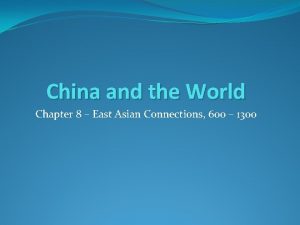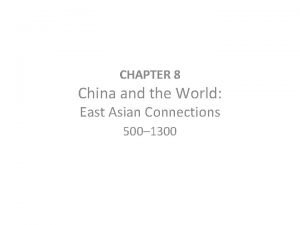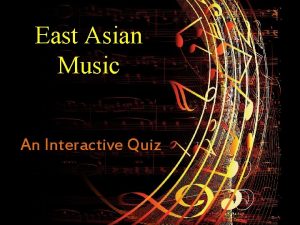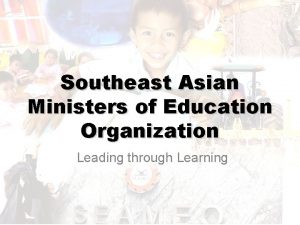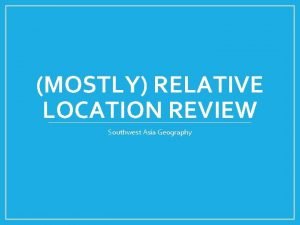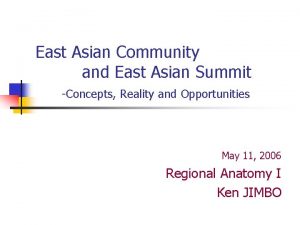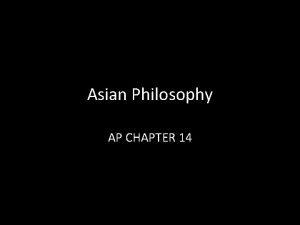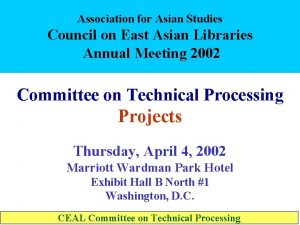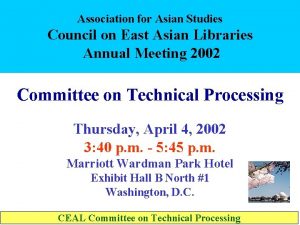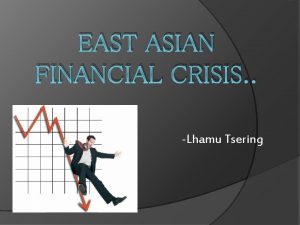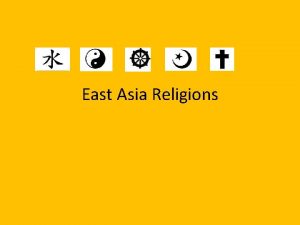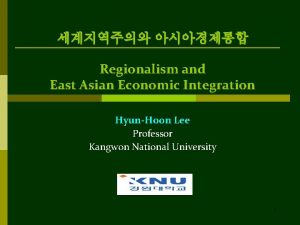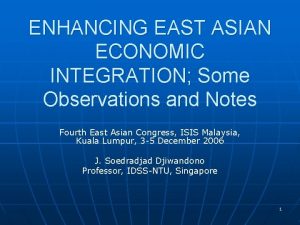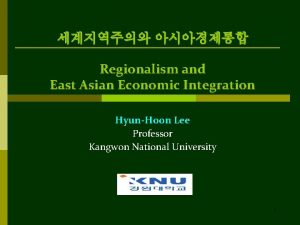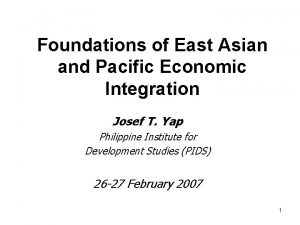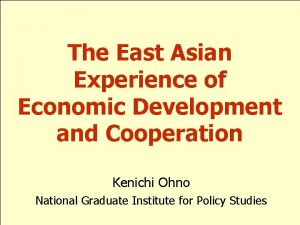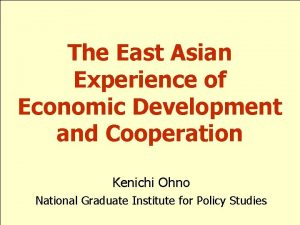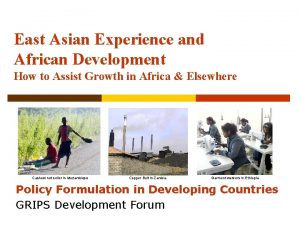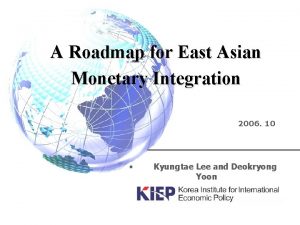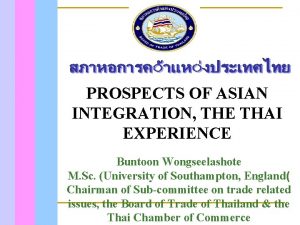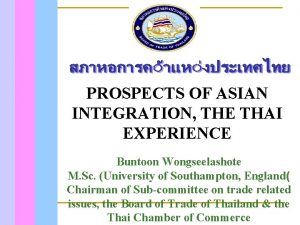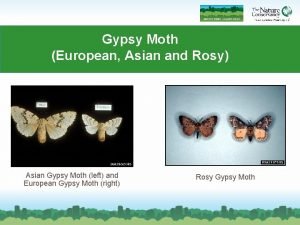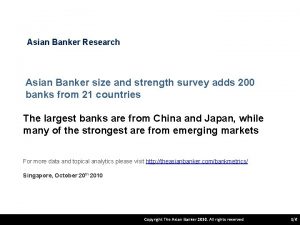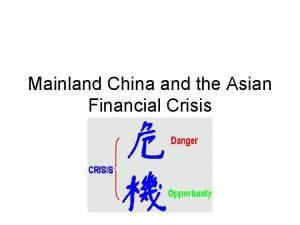The EU Experience and East Asian Integration Is


































- Slides: 34

The EU Experience and East Asian Integration: Is There a Genuine Path? Ramon Santacana, Providence University, Taiwan Yi-Ju Wang, Overseas Chinese University, Taiwan

PRESENTATION OUTLINE 1. Introduction 2. Evolution of the European Integration 3. Achievements and Present Situation on East Asian Integration 4. EU and East Asia: A comparative Approach 5. The Quest for a Genuine East Asian Integration Path 6. Conclusions

Introduction (1/3) • The East Asia region has had the most impressive economic growth in recent decades. • It integrated in the global economy with remarkable success. • Much of the literature that compares EU and East Asia integration and tries to provide a path for East Asian integration.

Introduction (2/3) • The countries in the region are very active trying to enhance regional economic cooperation and set up integration institutional frames

Introduction (3/3) • They want to make their economies stronger and better prepared for: Ø Ø global financial crises environmental crises food security disaster prevention and others

Economic Integration Definition (1/2) • The combination of several national economies into a larger territorial unit. • It implies the elimination of economic borders between countries. • Economic borders: any obstacle which limits the mobility of goods services and factors of production between countries.

Economic Integration Definition (2/2) • integration include two aspects: ▫ Negative integration: the elimination of obstacles. ▫ Positive integration: harmonization, coordination of existing instruments.

Evolution of the European Integration • The European Union is the largest and most integrated collection of countries working together in political and economic harmony. • The path to the European Union has spanned sixty years and had several revamps

EU Members Expansion • After the 6 founding members, in 1973 entered Kingdom, Ireland Denmark. Greece joined in 1981, Spain and Portugal in 1986. • East Germany joined the community de facto when it merged with West Germany in 1990. • After the ratification of the Maastricht Treaty, Austria, Sweden and Finland joined became full members in 1995.

• The biggest expansion came in 2004, with the entrance of Poland, Hungary, the Czech Republic, Slovenia, Slovakia, Malta, Cyprus, Latvia, Lithuania and Estonia. • The latest enlargement included Bulgaria and Romania in 2007. • This brought the number of countries in the European Union to a grand total of 27.

The European Union: 27 countries 500 million people Member states of the European Union Candidate countries

The Treaty of Lisbon(1/4) • Is the latest change to the European Union, • was completely ratified by all members in November 2009. • for the first time there is a specific clause that addresses the possibility of a member country withdrawing from the Union.

The Treaty of Lisbon(2/4) • It changed the voting method in the Council, which will now have to include 55% of the Member States representing 65% of the population of the Union for a double majority. • One of the biggest changes that occurred to the structure of the EU was the creation of a President of the European Council, which is effectively the head of the European Union.

The Treaty of Lisbon(3/4) Gives the EU jurisdiction over of new things such as • freedom, • security and justice, • combating terrorism or tackling crime… • energy policy, • public health, • civil protection, • climate change, • services of general interest, • research, • space, • territorial cohesion, • commercial policy, • humanitarian aid, • sport, • tourism • administrative cooperation. ”

The Treaty of Lisbon(4/4) • It also consolidated all of the negotiating power available to the Union into one position so as to make it easier to interact with countries outside of the Union and to make it more visible on the world stage.

The EU Treaties 1958 1952 The treaties of Rome: The European Economic Community The European Atomic Energy Community (EURATOM) The European Steel and Coal Community 2009 1987 Treaty of Lisbon The European Single Act: the Single Market 2003 Treaty of Nice 1999 Treaty of Amsterdam 1993 Treaty of European Union – Maastricht

East Asian Integration (1/6) Present Situation • Asian Institutional Framework for Regional Cooperation ▫ subregional groups ▫ regional entities such as ASEAN, ASEAN+3, or the East Asia Summit (EAS) transregional forums such as the Asia-Pacific Economic Cooperation and the Asia-Europe Meeting. ▫ As economic interdependence grows and Asian governments realize the benefits of regional collective action, the case for wider and deeper regional cooperation becomes stronger.

East Asian Integration: (2/6) Nature of Asian Economic Regionalism ▫ Institutional-light ▫ choose not to develop heavy regional institutions to avoid fat bureaucracies and to remain focused on economic integration driven by market forces more than government policies. ▫ The search for consensus Confucian values. ▫ pragmatic and flexible, ▫ “variable geometry”, different members may adapt their speed and depth of integration and cooperation

East Asian Integration(3/6) ▫ ASEAN’s momentum is indeed positive: the Secretariat is expanding its functions, number of staff, and gaining new support from external agencies. ▫ pivotal role ASEAN can play in Asia’s economic architecture and the process of regionalism. ▫ balancing force between the large economies of Japan and the PRC, and can take on an increasing leadership role in the region ▫ “ASEAN-x” to allow some members to join cooperation initiatives only when they are internally ready

East Asian Integration(4/6) Intraregional Production Networks ▫ In East Asia, regionalism is the outcome of free market forces bringing closer economic interaction and interdependence. ▫ Economic cooperation among national authorities across the region less important role. ▫ regional priorities started to emerge only recently, especially after Asia was hard hit by the financial crisis of 1997/98, The crisis induced the region to respond collectively. ▫ driven by market integration and only lately supported by intergovernmental policy cooperation ▫ a major difference with Europe, it also deeply affects the nature, sequencing, and timing of the regionalization process itself. ▫ The growth of industries such as electronics and automotive creation of regional production networks ▫ multinational firms to fragment production throughout the region, generating a conspicuous volume of intraregional trade in parts, components, and related services. Today, the share of intraregional trade in ASEAN+3 is close to 50% of the total

East Asian Integration(5/6) Trade Policy Cooperation ▫ Asian governments have not been active in promoting regional cooperation initiatives unilateral liberalization efforts or through multilateral negotiations ▫ During the last few years, however, Asian governments have embraced a substantial shift away from the unilateral and multilateral liberalization approach in favor of bilateral and plurilateral free trade and investment agreements.

East Asian Integration(6/6) Regional Financial Integration and Cooperation ▫ opposite path ▫ integration of financial markets among East Asian countries is still low, while regional cooperation is quite advanced. ▫ Since the 1997/98 financial crisis, however, Asian countries have introduced deep structural reform of their financial systems, strengthening their stability, efficiency, and improving their regulatory frameworks.

Lessons from EU Integration • Asia and Europe can learn from their regional economic integration and cooperation experiences • The EU’s main characteristics are: ▫ (i) a political vision for the region’s economic development; ▫ (ii) the creation of strong regional institutions, a single market, and the euro; ▫ (iii) the use of policies designed to overcome intraregional income inequalities, in a detailed framework of written laws and rules. • The EU provides a clear example of the importance of creating a backbone of economic laws and good market governance, to clearly define powers , and to introduce specific rules for proportional contributions to the budget.

Lessons from EU Integration • Importance given to the tools for implementing economic and social policies • policies tend to work well because the implementation mechanisms are carefully studied. • Other lessons came from the policy of decentralizing, whenever possible, the implementation of the economic measures

Lessons from EU Integration • European integration is not only about economics; it is also a political and a social project • The original ideal was a political one strong political commitment and cooperation among key countries • peer-pressure plays a very effective and positive role in increasing regional efficiency • social aspects income inequality and workers’ rights.

Negative lessons of the EU model • Negative lessons of the EU model ▫ labour market and the adoption of expenditure programs, such as the CAP, introduced to buy off the opponents of integration. ▫ overly complex rules and regulations, based on equity more than pragmatic principles. ▫ the creation of a self-sustaining and at times unnecessary bureaucracy.

Lessons that EU can learn from East Asia ▫ Capacity to grow rapidly and continuously, based on the transfer of industries from more to less advanced regional economies, which implies a high degree of flexibility and adaptability. ▫ readiness quickly adapt to the changing economic environment but remains highly integrated with the rest of the world. ▫ “open regionalism”, least discriminatory component for non members.

Lessons that EU can learn from East Asia ▫ importance of stimulating market-driven economic dynamism ▫ to increase economic interdependence based on advances in productivity and competitiveness. ▫ pragmatic and flexible approach ▫ the reliance on trust and personal relations ▫ essential role of education

The Quest for a Genuine East Asian Integration Path • EU-Style Integration versus “Pragmatic Integration” in Asia • Time to Integrate (Economically) • Asia: Integration without Institutionalisation • An Asian Identity through Economic Integration?

Conclusions (1/4) • EU-style integration cannot serve as a role model for Asia and Asian integration • Also there is no agreement on who should lead the Asian integration processes either within ASEAN or in East Asia, or South Asia. • Asian integration will, at least for the time being, remainly limited to economic integration through the establishment of free trade agreements.

Conclusions: Political v. s Economic (2/4) 1. Whereas political integration in Asia will remain very limited. 2. As for further political integration in Asia, the principle of noninterference in international affairs of other nations will continue to rein. 3. the kind of integration that requires real sovereignty-sharing will not be developed in the foreseeable mid term. 4. Economic integration initiatives through bilateral and multilateral free trade agreements 5. Asian governments are acknowledging the mutual benefits of economic integration and interdependence.

Conclusions: Regional Security (3/4) • Asian integration and multilateral co-operation in the field of security will also remain very limited. • It is hoped that the ASEAN Regional Forum (ARF) will gain influence and clout in shaping regional security. • ARF has been successful in bringing China into a regional security dialogue • The ASEAN principle of non-interference in internal affairs will continue to keep the forum from legallybinding decisions.

Conclusions: China (4/4) • With its growing economic weight and political influence, China is expected to take a leading role in the ARF • its recent initiative to include Defense Ministers in its meetings is an indication that China is willing to discuss regional security issues on a multilateral basis.

• Thank you.
 Chapter 8 china and the world
Chapter 8 china and the world Chapter 8 china and the world east asian connections
Chapter 8 china and the world east asian connections Meter of the song sakura
Meter of the song sakura The southeast asian ministers of education organization
The southeast asian ministers of education organization Which southwest asian country is the farthest east
Which southwest asian country is the farthest east What is indirect experience
What is indirect experience East is east and west is west
East is east and west is west Imprint definition psychology
Imprint definition psychology Continuity vs discontinuity
Continuity vs discontinuity Wind is horizontal movement of air
Wind is horizontal movement of air North american
North american Three dimensions of corporate strategy
Three dimensions of corporate strategy Backwards intergration
Backwards intergration Simultaneous integration examples
Simultaneous integration examples What is a key stone species
What is a key stone species Black and asian counselling network
Black and asian counselling network Hình ảnh bộ gõ cơ thể búng tay
Hình ảnh bộ gõ cơ thể búng tay Slidetodoc
Slidetodoc Bổ thể
Bổ thể Tỉ lệ cơ thể trẻ em
Tỉ lệ cơ thể trẻ em Voi kéo gỗ như thế nào
Voi kéo gỗ như thế nào Tư thế worm breton
Tư thế worm breton Chúa yêu trần thế alleluia
Chúa yêu trần thế alleluia Môn thể thao bắt đầu bằng chữ đua
Môn thể thao bắt đầu bằng chữ đua Thế nào là hệ số cao nhất
Thế nào là hệ số cao nhất Các châu lục và đại dương trên thế giới
Các châu lục và đại dương trên thế giới Cong thức tính động năng
Cong thức tính động năng Trời xanh đây là của chúng ta thể thơ
Trời xanh đây là của chúng ta thể thơ Cách giải mật thư tọa độ
Cách giải mật thư tọa độ 101012 bằng
101012 bằng Phản ứng thế ankan
Phản ứng thế ankan Các châu lục và đại dương trên thế giới
Các châu lục và đại dương trên thế giới Thơ thất ngôn tứ tuyệt đường luật
Thơ thất ngôn tứ tuyệt đường luật Quá trình desamine hóa có thể tạo ra
Quá trình desamine hóa có thể tạo ra Một số thể thơ truyền thống
Một số thể thơ truyền thống
